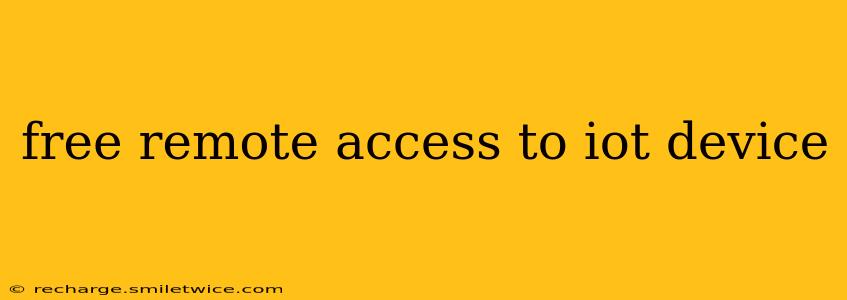The Internet of Things (IoT) has revolutionized how we interact with the world, connecting everyday devices to the internet and enabling remote control and monitoring. But gaining secure and reliable remote access to these devices, especially for free, presents unique challenges. This guide explores the possibilities, limitations, and security considerations involved in achieving free remote access to your IoT devices.
What are the Different Methods for Remote Access?
Several methods exist for remotely accessing your IoT devices, each with its own set of advantages and disadvantages. Some require paid subscriptions, while others offer free, albeit potentially less robust, options.
-
Built-in Remote Access Features: Many IoT devices come with built-in remote access capabilities through dedicated mobile apps or web portals. These often provide a user-friendly interface but may lack the flexibility of more general-purpose solutions. The availability of free access depends entirely on the manufacturer and the specific device.
-
Third-Party Apps and Services: Numerous third-party apps and services offer remote access to IoT devices. Some offer free plans with limited functionality, while others are subscription-based. The security of these services is crucial, and thorough research into the provider's reputation and security practices is essential before use.
-
VPN (Virtual Private Network): Using a VPN can provide a secure connection to your IoT devices, encrypting your data and protecting it from unauthorized access. While many VPN services are paid, some offer free plans with data limits. However, free VPNs often compromise on security and privacy, so caution is advised.
-
Port Forwarding: This involves configuring your router to forward specific ports to your IoT device. This allows direct access but requires technical expertise and poses significant security risks if not properly configured.
-
Cloud-Based Platforms: Services like AWS IoT Core, Google Cloud IoT Core, and Azure IoT Hub offer cloud-based platforms for managing and accessing IoT devices. While they generally require payment for continued use beyond free tiers, they provide powerful features for managing many devices. Free tiers are often limited by the number of devices and messages handled.
Is Free Remote Access Always Safe?
Security is paramount when accessing IoT devices remotely. Free solutions often come with compromises, including limited security features, potentially less robust encryption, and higher vulnerability to attacks. Using a reputable, paid service is generally recommended for sensitive data or critical infrastructure.
What Security Risks are Associated with Free Remote Access?
- Data Breaches: Unsecured remote access can expose your device and personal data to hackers.
- Malware Infections: A compromised device can be used to spread malware to other devices on your network.
- Device Control: Hackers can gain unauthorized control of your device, potentially causing damage or disruption.
How Can I Secure My Remote Access?
Regardless of whether you use a free or paid service, strong security practices are essential.
- Strong Passwords: Use strong, unique passwords for all your IoT devices and access accounts.
- Two-Factor Authentication (2FA): Enable 2FA wherever possible to add an extra layer of security.
- Regular Software Updates: Keep your IoT devices and associated software updated to patch security vulnerabilities.
- Firewall: Configure your router's firewall to restrict access to your IoT devices.
- Network Segmentation: If possible, isolate your IoT devices on a separate network segment from other devices.
What are the Best Free Options for Remote Access?
While many free options exist, it's crucial to remember that completely free and secure remote access to IoT devices is extremely rare. The functionality and security of "free" options are often severely limited. Many "free" apps or services might include hidden costs, intrusive advertising, or data collection practices. Thorough research is crucial to determine if a solution is suitable for your needs and risk tolerance. It's often worthwhile to evaluate the limitations of a free option against the costs of a more secure paid service.
How Can I Find the Right Remote Access Solution for My Needs?
Consider the following factors when choosing a remote access solution:
- Device Compatibility: Ensure the solution supports your specific IoT devices.
- Security Features: Evaluate the security features offered, such as encryption and authentication methods.
- Ease of Use: Choose a solution that is easy to set up and use, even for non-technical users.
- Cost: Consider the total cost of ownership, including any subscription fees or hidden charges.
- Scalability: If you plan to add more IoT devices in the future, make sure the solution can scale to accommodate your needs.
Finding a perfect balance between cost and security is a crucial aspect of ensuring the reliability and safety of accessing your IoT devices remotely. Remember that security should never be compromised for the sake of cost savings.
